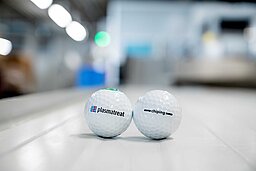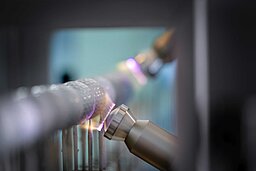Plasma for Smart Golf Ball Production
Download the full version in English here
Download the full version in German here
With its vision of equipping golf balls with GPS tracking to make them easy to find in rough terrain, the Swiss company Chip-ing AG is playing a pioneering role in the digitalization of golf worldwide. Openair-Plasma technology from Plasmatreat GmbH contributes significantly to the efficient production and durability of smart golf balls, making the innovative idea a lasting success.

The new technology also offers greater sustainability in recreational golf. It is estimated that around 300 million golf balls are lost every year in forests or tall grass. Golf balls are made primarily of high-quality plastics and rubber compounds containing up to 15 different components. Some of these contain heavy metals. On average, golf balls weigh just under 50 grams. In short, more than 15,000 tons of micro- and nanoplastics, as well as heavy metals, are released into the environment on golf courses worldwide every year.
This can be avoided with Chip-ing's GPS-trackable golf balls. Golfers can quickly find lost balls using a smartphone app that connects to the balls via Bluetooth and recycle them at the end of their life.
The production of these balls requires more than 50 steps. Some of these steps present challenges in terms of surface finish and reliable adhesion between different materials. Reliable adhesion is crucial for the quality and durability of golf balls because they must withstand extremely high impact forces and accelerations of up to nearly 100,000 g when struck.

The company was looking for an efficient and reliable method of surface pretreatment. Considering its many advantages, Chiping chose Openair-Plasma technology, complete with quality assurance from Plasmatreat. The technology is currently used in two important process steps. Using electricity and compressed air, high-energy plasma is generated in specially developed rotary nozzles for plastics and directed onto the surfaces of golf balls. This process removes the finest organic contaminants and activates the uppermost molecular layers of the plastic. This creates new functional groups that act as invisible anchors, ensuring that paints and printing inks adhere permanently and reliably without the need for solvents or chemical primers.

